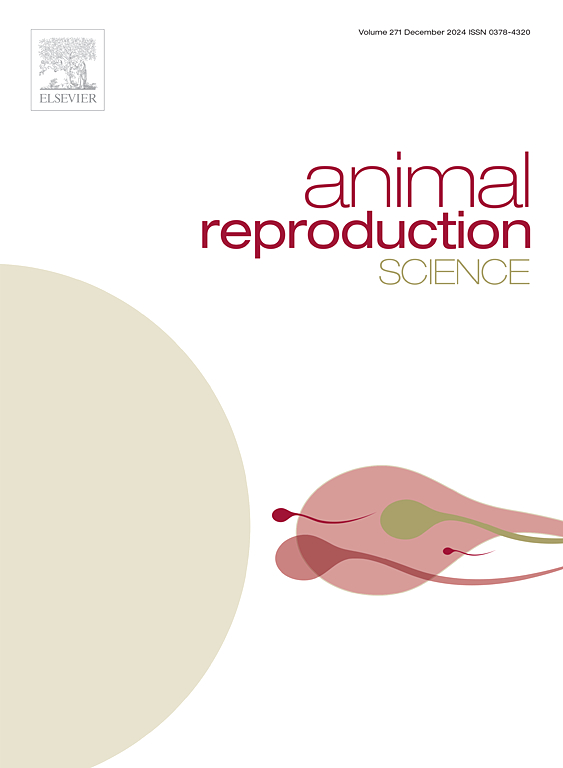Salinity and pH affect common bottlenose dolphin (Tursiops truncatus) sperm viability
IF 2.2
2区 农林科学
Q1 AGRICULTURE, DAIRY & ANIMAL SCIENCE
引用次数: 0
Abstract
The female reproductive environment modulates sperm fertilization potential and may exert numerous selective forces on sperm during fertilization. Exploring cetacean (whales, dolphins, and porpoises) sperm responses to variable extracellular salinity and pH, either from seawater exposure or from the vaginal environment, offers insight into the selective pressures exerted on sperm in aquatically-mating mammals. This study examined common bottlenose dolphin (Tursiops truncatus) sperm motility, plasma membrane integrity, morphology, and acrosome integrity upon semen exposure to biologically relevant extracellular salinities (0–40 ppt) and in situ measured dolphin vaginal pHs (5–7.4). Sperm motility and kinematics were assessed by computer-aided sperm analysis (CASA). Sperm plasma membrane integrity, morphology, and acrosome integrity were assessed post-hoc. Dolphin sperm motility and plasma membrane integrity significantly decreased when exposed to solutions ≥ average oceanic salinity (35 ppt). Vaginal pHs were highly variable among individuals (pH 5.04–7.4). Sperm motility appeared optimal at pH 7 and sperm viability decreased significantly at pHs < 6.5. There was more inter-individual variation in sperm motility and kinematics when exposed to pHs < 7 compared to any salinity. Optimal extracellular salinity (8 – 15 ppt) and pH (pH 7) ranges that improve sperm motility and viability can inform dolphin semen processing methods for cryopreservation.
盐度和pH值影响普通宽吻海豚(Tursiops truncatus)的精子活力
雌性生殖环境调节精子受精的潜力,并可能在受精过程中对精子施加许多选择力。研究鲸类动物(鲸鱼、海豚和鼠海豚)的精子对细胞外盐度和pH值变化的反应,无论是来自海水暴露还是来自阴道环境,都有助于深入了解在水中交配的哺乳动物中施加在精子上的选择压力。本研究检测了普通宽吻海豚(Tursiops truncatus)在精液暴露于生物相关的细胞外盐度(0-40 ppt)和原位测量的海豚阴道ph(5-7.4)时的精子活力、质膜完整性、形态和顶体完整性。通过计算机辅助精子分析(CASA)评估精子活力和运动学。事后评估精子质膜完整性、形态和顶体完整性。当暴露于≥ 平均海洋盐度(35 ppt)的溶液时,海豚精子活力和质膜完整性显著降低。个体间阴道pH值差异较大(pH值为5.04 ~ 7.4)。pH为7时精子活力最佳,pH为<; 6.5时精子活力显著下降。与任何盐度相比,当暴露于ph <; 7时,精子活力和运动学的个体间差异更大。最佳细胞外盐度(8 - 15ppt)和pH (pH 7)范围可以提高精子活力和活力,为海豚精液冷冻保存的处理方法提供信息。
本文章由计算机程序翻译,如有差异,请以英文原文为准。
求助全文
约1分钟内获得全文
求助全文
来源期刊

Animal Reproduction Science
农林科学-奶制品与动物科学
CiteScore
4.50
自引率
9.10%
发文量
136
审稿时长
54 days
期刊介绍:
Animal Reproduction Science publishes results from studies relating to reproduction and fertility in animals. This includes both fundamental research and applied studies, including management practices that increase our understanding of the biology and manipulation of reproduction. Manuscripts should go into depth in the mechanisms involved in the research reported, rather than a give a mere description of findings. The focus is on animals that are useful to humans including food- and fibre-producing; companion/recreational; captive; and endangered species including zoo animals, but excluding laboratory animals unless the results of the study provide new information that impacts the basic understanding of the biology or manipulation of reproduction.
The journal''s scope includes the study of reproductive physiology and endocrinology, reproductive cycles, natural and artificial control of reproduction, preservation and use of gametes and embryos, pregnancy and parturition, infertility and sterility, diagnostic and therapeutic techniques.
The Editorial Board of Animal Reproduction Science has decided not to publish papers in which there is an exclusive examination of the in vitro development of oocytes and embryos; however, there will be consideration of papers that include in vitro studies where the source of the oocytes and/or development of the embryos beyond the blastocyst stage is part of the experimental design.
 求助内容:
求助内容: 应助结果提醒方式:
应助结果提醒方式:


